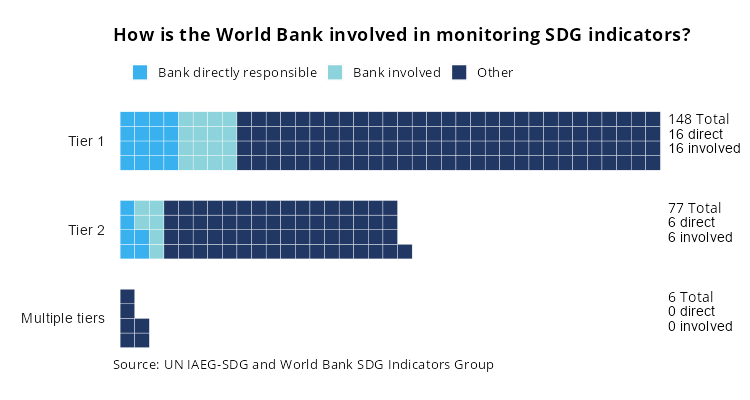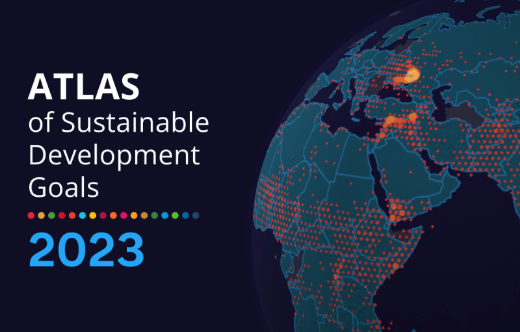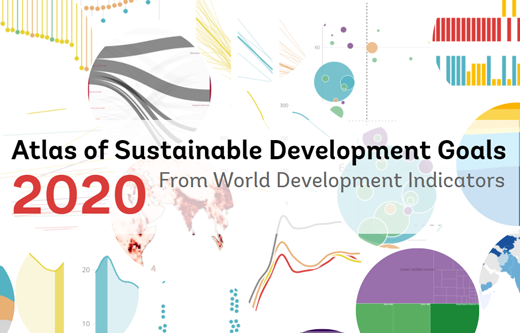What are the Sustainable Development Goals?
In 2015, leaders of 193 countries agreed on a set of 17 Sustainable Development Goals (SDGs) to guide global action for the next 15 years. Set out in the 2030 Agenda for Sustainable Development, the SDGs form an ambitious plan to promote sustainable development for the benefit of all people and the planet. The World Bank's expertise in development data and its large repository of development indicators play important role in keeping track of progress against the goals.
How does SDG monitoring work?
To monitor the SDGs, a framework of 169 targets and 230+ indicators has been developed by the Inter-agency and Expert Group on SDG Indicators (IAEG-SDGs), a group of UN Member States with international agencies as observers. The indicators were initially classified into three tiers: Tier 1 indicators are those with an established methodology and good data coverage, Tier 2 have an established methodology but lack good data coverage, and Tier 3 indicators lacked both sound method and adequate data. As work on the methodological and data gathering has continued, as of March 2020, the global indicator framework does not contain any Tier III indicators. The tier classifications for indicators keep changing as methodologies are developed and data availability increases. As of March 31, 2023, the tier classification contains 148 Tier 1 indicators, 77 Tier 2 indicators. In addition to these, there are 6 indicators that belong to multiple tiers as different components of the indicator are classified under different tiers.
Different international agencies are assigned as 'custodians' of the SDG targets. In this capacity, they work with national statistical offices to develop methodologies for indicators to measure progress on the SDGs. The agencies also work with countries to compile data for SDG indicators, which they submit to the UN Statistics Global SDG database.
How is the World Bank involved in monitoring SDGs?
The World Bank participates in IAEG-SDGs as an observer and is a custodian or co-custodian (with other agencies) for 22 indicators. In addition the Bank is involved in the development and monitoring of an additional 22 indicators. The indicators cover a wider range of topics in which the World Bank has expertise, including poverty and inequality, social protection, gender equality, financial access, remittances, health, energy, infrastructure, among other.
The World Bank's own corporate goals align closely with the SDGs. Notably, the poverty and inequality related SDG targets 1.1 and 10.1 are directly linked to the Bank's twin goals of ending extreme poverty and promoting shared prosperity in a sustainable and inclusive manner. Sustainability is at the heart of several SDG goals and is explicitly embedded in goals 6 (water), 7 (energy), 8 (jobs), 11 (cities), 12 (sustainable consumption), 13 (climate), 14 (life below water), 15 (life on land).
Within the World Bank, the SDG Indicators Group constituted of subject matter experts across different thematic groups, provides technical input to the IAEG-SDGs and reports the indicator estimates for which the institution is responsible. Members of this group have worked with other agencies and countries (national statistical offices and relevant ministries) to develop methodologies for SDG indicators and to facilitate reporting. A major goal of the SDG Indicators Group is to improve the data quality (and consequently the tier status) of these indicators. As of March 31, 2023, of the 22 indicators the Bank is responsible for 16 are Tier 1 and 6 are Tier 2.

Apart from its role in monitoring the SDGs, the World Bank also plays a role in the achievement of the 2030 agenda, working with client countries to deliver on the 2030 agenda by providing support in three critical areas: (i) finance, (ii) data, and (iii) implementation – supporting country-led and country-owned policies to attain the SDGs.
How does the World Development Indicators showcase the SDGs?
The World Bank's premier data compilation, the World Development Indicators (WDI), takes a comprehensive view of the world, presenting almost 1500 indicators relevant to development. It currently includes many of the official SDG indicators as well as other data that are relevant to SDGs. For example, in addition to official indicators on the income/consumption growth of the bottom 40 percent of the population relative to the average as per SDG target 10.1, the WDI presents indicators like the Gini index or income shares by decile or quintile that are relevant for SDG 10 on inequality. For the SDG target related to access to social protection programs (target 1.3), the WDI presents data on different forms of social protection: social assistance (such as cash and in-kind transfers), social insurance (such as pensions and unemployment insurance), and active labor market programs (such as skills training and wage subsidies), as well as associated data on amounts of assistance.
What are some of the available SDG data resources?
The Atlas of Sustainable Development Goals presents a visual guide to key SDGs developed by World Bank experts and, through engaging charts and maps, supports a better understanding of the progress achieved. The Atlas draws on data from the WDI, and also explores new data from researchers in those areas where standards for measuring SDG targets are still being developed.
Users can also explore country trends and regional distributions, through custom WDI database inquires.


